Hi, everyone! This thread is a true story about an unique and bizarre polar expedition, which happened in the late 19th century. Swedish Salomon August Andree was the captain of this ill fated three-men arctic balloon expedition of 1897. The idea of this thread is to narrate the influencing factors in the backgrounds of the expedition, picture the different phases of the voyage itself, raise causes and consequences and make a final conclusion. There are also story images and maps relating to the expedition for entertaining the reader.
The Heroic Age of Polar Exploration
This is the latter half of 19th century, often linked only to the Antarctic regions, but the event influenced a lot to the Arctic exploration also. The inhospitality and the dangers of these regions appealed powerfully to the imagination of the age. The exploration of the polar areas was experienced as a challenge to be conquered by technological inventions of industry and manly daring exploits. National enthusiasm had a strong impact in this international race between different nations. Sometimes, or should it be said more often the technological and human limits were tested and exceeded on this age of exploration following with disastrous ends.
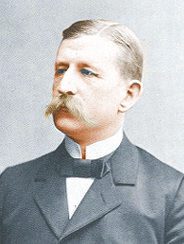
Salomon August Andree (1854-1897)
The Swede, S. A. Andree shared the national enthusiasm and proposed a plan in public of an arctic balloon expedition. In Andree's plan the hydrogen balloon was propelled by the wind and fine-tuned with the drag-rope steering technique he had invented. The balloon would take off from Svalbard, cross the Arctic Sea and on its way to Russia, Canada, Bering Straight, or Alaska it would with luck cross the North Pole as well. This strategy sounds a bold one, at least, the plan was very unofficial and loose with the standards of a modern day, but the scheme was received with high national enthusiasm in Sweden, the northern nation that had fallen behind in the race for the North Pole.

This is an overview of the rough flight-plan presented by Andree
The time was propitious for Andree, he was convincing in his speeches and a succesful fundraiser too. Thrilled by Andree's lecture in Royal Swedish Academy of Sciences, the Swedish politicians and scientists were eager to see Sweden take the lead in the race for the North Pole. Andree's plan was supported with very significant financial contributions by prestigious people, King Oscar II of Sweden and Alfred Nobel among the others.
In more detailed plan Andree sorted out the needed conditions and resources for the expedition. A hydrogen balloon with lifting power to carry three men, advanced cameras, scientific equipment, provisions for four months and ballast 3 000kg was needed. Andree assured the supporters, that arctic summer was the best suitable by its weather for ballooning, the midnight sun would enable observations round the clock, halving the 60-day travel time and do away the anchoring needed in nightime. Also the winds would favor and the steering would be done routinely. The drag-rope steering technique was well adapted to the region, where the ground, consisting of ice was "low in friction and free of vegetation", he said. Andree also argued, that the minimal precipitation of the area would not pose a threat of weighing down the balloon. At above-zero temperatures the precipitation would melt and below-zero temperatures the precipitation would blow off for the balloon will be travelling more slowly than wind. Andree's arguments received approval, but the financiers and the audience were not informed of the Arctic summer storms, fogs, high humidity and ever-present threat of ice formation. Whether these factors would have affected to the opinions, it was a rush to support Andree's effort and he received financial assistance corresponding todays money, 1 million US dollars.
The failure of 1896, not everyone agrees with Andree
For the first attemp to launch the balloon, Andree had picked a crew of two other explorers. Nils Ekholm was an experienced meteorological scientist and Nils Strindberg, a brilliant student in physics and chemistry. One purposes of the Expedition was to map the travelled area by means of aerial photography, it was a job for Strindberg, who was skilled with cameras. The team had very good scientific and technical skills, but they were lacking of physical training, all three members were kind of indoor-types and survival skills under extreme conditions were far down in Andree's list.
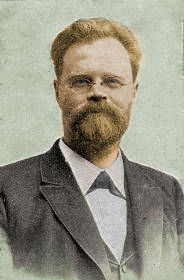
Nils Ekholm disagreed with Andree
Experienced in skills, Ekholm was skeptical about the balloon's ability to retain hydrogen. In Svalbard he did his measurements and calculated, that the balloon was leaking too much to reach the North Pole, let alone go to Russia or Canada. Ekholm estimated, that the balloon was able to stay 17 days airborne at most, not 30. He warned Andree about this, but Andree refused the crticism to the point of deception. It had come to Ekholm's knowledge, that Andree had secretly ordered extra-topping of the hydrogen in the balloon.
On top of all this, the wind, blowing steadily from the north refuted Andree's optimism, the launch wasn't possible in the summer of 1896. The team had to pack up and return to Sweden. But at least something was done, a balloon hangar was completed. It would shelter the balloon for the coming winter. The argument and the reluctance of Andree in making corrections the indentifed failings made Ekholm to withdraw from the project - in hindsights, it was all for his own personal good.
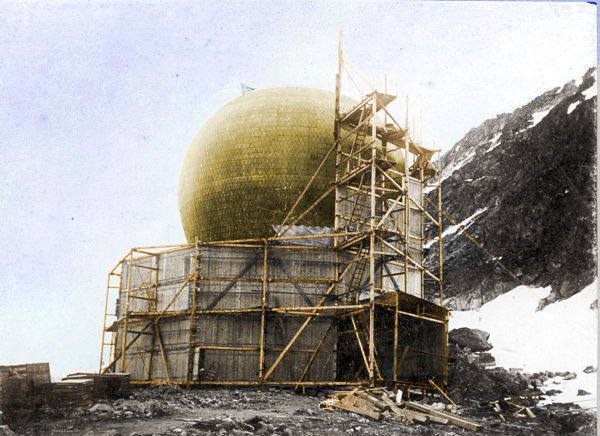
This is the balloon hangar and Andree's balloon, Örnen - The Eagle in the Danes Islands, Svalbard
1897 - New crew, new attempt
From the candidates Andree picked Knut Fraenkel to replace Ekholm. Fraenkel was 27-years old civil engineer and a strong athlete and did mountain hikes, so now there was skills in survival techniques in the crew. Fraenkel was given the meteorological observation post in the expediton and even he had no earlier experience in that field, he managed efficiently the task, this turns out from his preserved meteoroligical journal. Andree's choice to replace Ekholm has been carefully considered, Ekholm was experienced and critical, Fraenkel was young, unexperienced and an enthusiast - now Andree had strenghtened his personal leadership. The Andree Expedition crew was ready, the captain 43-years old, the meterologist 27-years old and the photographer 25-years old.
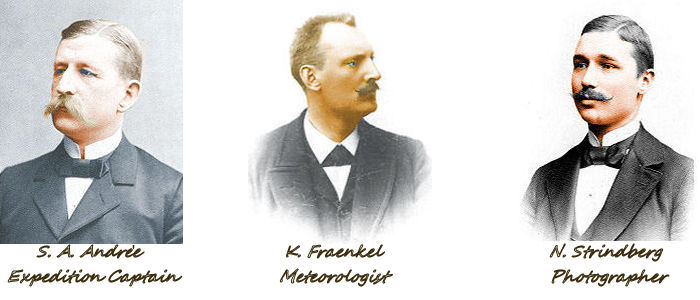
The crew of Andree Expedition
The winds in the Danes Island were more favorable too and after the final inspection The Eagle was launched with the crew aboard on July 11th, 1897.

The final inspection of The Eagle - hard to find any safety equipment with modern day standards, but judging by the shoes, this crew bewares causing any leaks for the balloon
The flight and the crash
The expedition crew climbed in the already heavy basket, Andree dedicated last minute telegrams, one for the Oscar II and one for the Aftonbladet - holder of the press rights of the Andree Expedition. Large support team cut the ropes holding The Eagle and it rose slowly. The balloon flew low, only just over the water, it was pulled down by the friction of the several hundred meters long drag-ropes and the basket was to dip into the water. To get the basket clear and off the water, most of the drag-ropes had to be cut. Together, ropes and sandbags, over 700kg was thrown overboard. Before The Eagle had cleared the launchsite it had to come from supposedly steerable craft into an ordinary hydrogen balloon on the mercy of the winds just in few minutes. The crew had no means to direct it to any goal anymore and the ballast for stability was mostly gone too.
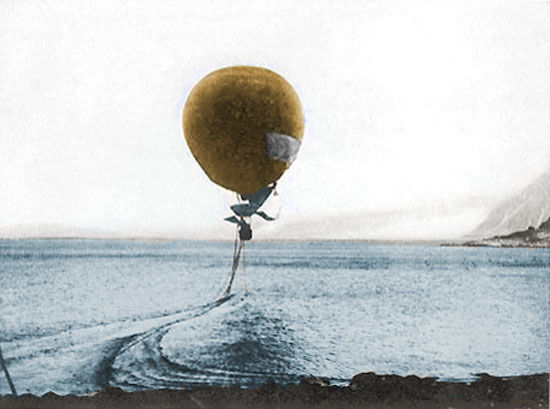
This image is propably just after the critical moments, at least The Eagle has gained
some height above the sea level
Now, avoiding an immediate failure the crew had to ways to contact the outside world - first one was the pigeons onboard - and the second one was the buoys. The buoys were steel cylinders encased in cork, intended to be dropped into the water or ice. Only two buoys have ever been found. One was dispatched after a few hours of flight and the message states, that the journey goes well so far and altitude is 250m. Second was dropped just after the first one and gave the height of 600m. Andree released also at least four of the pigeons, but only one reached the outside world, the message is dated on July 13th and states the same, all goes well on board, third message sent by pigeon.
The onboard messages, intended to be published were only brief and made an optimistic image of the Andree Expedition. But they failed to give the real circumstance of the voyage, the real conditions are clarified in Andree's personal journal, which was recovered later. In reality the atmosphere was increasingly desperate, messages dispatched from the balloon - there are no mentions of the early accident at takeoff, the balloon had no equilibrium and because the loss of ballast, the balloon flew too high and thereby was losing more hydrogen even estimated in Ekholm's calculations. The balloon was also weighed down being rain-soaked and the men threw all the sandbags and even some of the payload in efforts to save the balloon.
Free flight lasted some 10 hours and followed with 41 hours of bumpy ride with frequent ground contact before the crash.
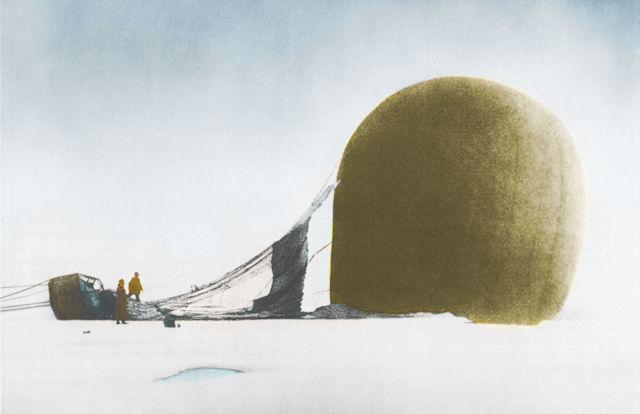
The Eagle has crashed on pack ice, July 14th 1897 - the crash was gentle, no damage for crew or equipment
The journey and the struggle on ice

This map gives an overview of the Andree Expedition. I means the launchsite on July 11th, Danes Islands II means the crash site on July 14th on pack ice, III means the final campsite on White Island
The solid white line is the flight route July 11-14. The line with white dots is the walk on the ice from July 14th-October 6th. The actual distance traveled was not so straightforward as seen on the map.
From the moment The Eagle was crashed, Strindberg's camera became a recorder of daily life in the icescape and drudgery of the trek, over 200 photos was shot. Contrary to Andree's and Fraenkel's journals, Strindberg had his own diary with personal reflections on the expedition and messages for his fiancee as well.
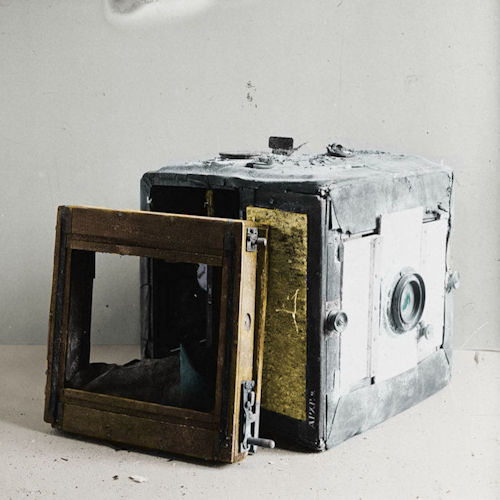
Strindberg's camera
The Eagle had been stocked with many safety equipment such as guns, snowshoes, skis, a tent, a small boat, etc. The problem was, that the items were not storaged with care, there was no instructions or manuals for dealing in extreme environment. Channels separating the ice floes, high ridges and iced-over melt ponds, dreadful terrain, called Andree. The men's clothes included no furs, just woollen coats and trousers plus oilskins.
Before the walk on the ice began, the expedition spent a week in a tent on the crash site making decisions where to go and how much to bring of the equipment. The North Pole was not an option anymore, the objective was set on the Franz Josef Land where it was known to be a deposit with food and ammunition.
On July 22nd, the expedition started the attempt to reach the Franz Josef Land. The men had loaded sledges with more than 200kg. Soon they realized, that it wasn't realistic. The sledges broke and wore out the men. After one week of ice-travel they had to leave piles of food behind. It became necessary to hunt the food. The Expedition shot seals, walruses and polar bears especially and half-cooked and ate the meat throughout the march.
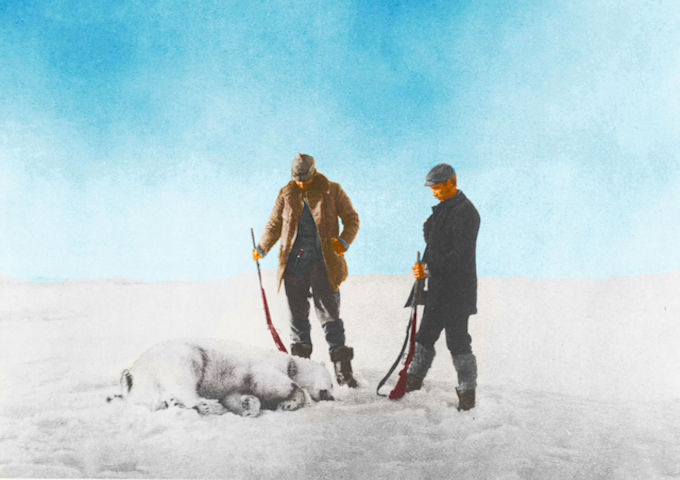
One of the many polar bears the Expedition encountered and ate
Another fact was also soon to be found among the Expediton crew - and it depressed them down to the bottom. Their two-week struggle on the ice was hardly bringing the goal any nearer. The drift of the ice was in the opposite direction and actually they were moving backwards. In August 4th, after discussion, the Expedition decided to change direction in the southwest, aiming other depo back in Svalbard islands. They estimated that the march there could take six or seven weeks. The terrain in this direction proved to be even more difficult and making any further progress the men were forced to crawl on all fours. Occasional relief was in the form of open water, now they could use their boat to cross these sections, paradise, wrote Andree.

Struggling with the terrain
The Expedition made headway, but it was apparent only. Soon the direction of the wind changed and they were again pushed backwards. On September the men resigned themselfs to wintering on a ice floe, letting it take them where it would. The men were drifting south, to the White Island. Finally, the ice floe began to break up near the shores of the White Island and they landed the island early on October. Andree made his last notes on his Journal shortly after arrived on the island. It is inferred from the inchorent pages, that the three men were all dead within a few days of moving onto island.
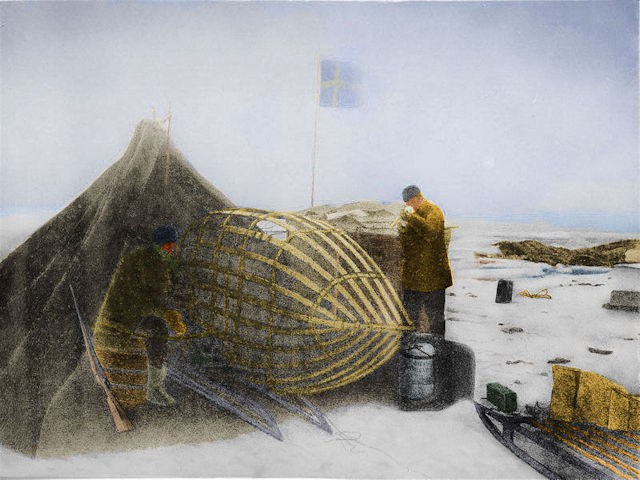
The wintering camp on White Island was built in extreme weather conditions and it was very primitive
Recovery of the Andree Expedition
For the next 33 years the fate of the expedition was shrouded in mystery and its disappearance part of cultural lore in Sweden. Actually, the international media interest on the expedition was much richer after its disappearance than before it.

Gunnar Horn
In summer 1930, Norwegian Bratvaag Expedition, with Gunnar Horn in command was studying glaciers and the seas of Svalbard region. The summer had been particularly warm and the sea surrounding the White Island was open. The Bratwaag Expedition took the opportunity and landed on the island. They soon discovered the remnants of the Andree Expedition wintering camp and uncovered a journal and two skeletons, indentified as Andree and Strindberg. Later, on September the surroundings were investigated more specifically and the remains of Fraenkel were also found among other artifacts. The bodies of the three explorers were transported to Stockholm, arriving on October 5th.
The homecoming of the bodies of Andree, Fraenkel and Strindberg was a grand event. King Gustav V delivered an oration and the explorers received a funeral with great honors.

The funerals of the three explorers in 1930
The causes of death
It's unlikely will we ever know the exact causes. The bodies were cremated without further examination. There are all kind of theories and studies, some done with exactitude of detective's eye. This subject affects both, interest and controversy. It's known for sure, that the explorers ate scanty amounts of canned and dry food from the balloon storages, instead they ate very huge portions (500gram - 2 000gram daily) of half cooked meat of polar bears, seals and walrus and this may explain something. Polar bear meat contains Trichinella and in high doses may cause death. It's same with Vitamin A, it stores in the livers of seals and polar bears and it's revealed from the journals, that the explorers ate also this. There is also theories of committing suicides, the winter-over syndrome is known, it can its worse cause suicidal features in human. It must be taken account, that the men were totally exhausted and desperate after the march on the ice and this only, can be very dangerous. Death of a gun shot is possible, frostbites, carbon monoxide poisoning, they are all in the list. One is not mentioned, polar bear attack. This may be possible, the expedition encounterd polar bears continually and the threat was always present. Writer-researcher, Bea Uusma concluded in 2010, that after examining the men's clothes at least Strindberg was killed in polar bear attack.
Causes of disaster, final words
There are multiple reasons why the Andree Expedition ended up with a disaster. Unfortunately many of those reasons are linked to Andree himself. In his time and in the following years Andree was seen as a daring pioneer in the field of aviation. He was a Swedish patriot, keeping on the dreams Sweden taking the scientific lead in the Arctic. More recently Andree's heroic status has been questioned.
Modern writers and researchers all agree, that Andree's scheme of the North Pole was unrealistic. Andree didn't have so many hours of flight experience and he was in serious troubles on his experimental balloon flights. He relied too much on the steering technique he had invented, the drag-rope system hardly exists in modern day balloon flights, it's ineffective. More or less Andree was with the mercy of the winds on his flights.
Andree's optimism, faith in the power of technology and disregard for the forces of nature led to serious consequences. He argued with Ekholm and ignored the facts, which were presented to him. Some of the troubles could have been avoided, if the balloon would have been tested in the Continental Europe, now the testing was done in Svalbard and too late.
It is true that the pressure accumulated on him because of his supporters and the social media of the 19th century, but still Andree was able to put a halt to the polar Project just if he wished. By the time Andree had became a prisoner of his own motives and successful fund raising campaign. The Andree Expedition did not accomplish its scientific objectives, even less did it give Sweden the advantage in the race for the North Pole.
![norra7_jmr[1].jpg norra7_jmr[1].jpg](https://forumcontent.paradoxplaza.com/public/324803/norra7_jmr[1].jpg)
Norra begravningsplatsen is the last resting place for the three men of the Andree Expedition
The Heroic Age of Polar Exploration
This is the latter half of 19th century, often linked only to the Antarctic regions, but the event influenced a lot to the Arctic exploration also. The inhospitality and the dangers of these regions appealed powerfully to the imagination of the age. The exploration of the polar areas was experienced as a challenge to be conquered by technological inventions of industry and manly daring exploits. National enthusiasm had a strong impact in this international race between different nations. Sometimes, or should it be said more often the technological and human limits were tested and exceeded on this age of exploration following with disastrous ends.

Salomon August Andree (1854-1897)
The Swede, S. A. Andree shared the national enthusiasm and proposed a plan in public of an arctic balloon expedition. In Andree's plan the hydrogen balloon was propelled by the wind and fine-tuned with the drag-rope steering technique he had invented. The balloon would take off from Svalbard, cross the Arctic Sea and on its way to Russia, Canada, Bering Straight, or Alaska it would with luck cross the North Pole as well. This strategy sounds a bold one, at least, the plan was very unofficial and loose with the standards of a modern day, but the scheme was received with high national enthusiasm in Sweden, the northern nation that had fallen behind in the race for the North Pole.

This is an overview of the rough flight-plan presented by Andree
The time was propitious for Andree, he was convincing in his speeches and a succesful fundraiser too. Thrilled by Andree's lecture in Royal Swedish Academy of Sciences, the Swedish politicians and scientists were eager to see Sweden take the lead in the race for the North Pole. Andree's plan was supported with very significant financial contributions by prestigious people, King Oscar II of Sweden and Alfred Nobel among the others.
In more detailed plan Andree sorted out the needed conditions and resources for the expedition. A hydrogen balloon with lifting power to carry three men, advanced cameras, scientific equipment, provisions for four months and ballast 3 000kg was needed. Andree assured the supporters, that arctic summer was the best suitable by its weather for ballooning, the midnight sun would enable observations round the clock, halving the 60-day travel time and do away the anchoring needed in nightime. Also the winds would favor and the steering would be done routinely. The drag-rope steering technique was well adapted to the region, where the ground, consisting of ice was "low in friction and free of vegetation", he said. Andree also argued, that the minimal precipitation of the area would not pose a threat of weighing down the balloon. At above-zero temperatures the precipitation would melt and below-zero temperatures the precipitation would blow off for the balloon will be travelling more slowly than wind. Andree's arguments received approval, but the financiers and the audience were not informed of the Arctic summer storms, fogs, high humidity and ever-present threat of ice formation. Whether these factors would have affected to the opinions, it was a rush to support Andree's effort and he received financial assistance corresponding todays money, 1 million US dollars.
The failure of 1896, not everyone agrees with Andree
For the first attemp to launch the balloon, Andree had picked a crew of two other explorers. Nils Ekholm was an experienced meteorological scientist and Nils Strindberg, a brilliant student in physics and chemistry. One purposes of the Expedition was to map the travelled area by means of aerial photography, it was a job for Strindberg, who was skilled with cameras. The team had very good scientific and technical skills, but they were lacking of physical training, all three members were kind of indoor-types and survival skills under extreme conditions were far down in Andree's list.

Nils Ekholm disagreed with Andree
Experienced in skills, Ekholm was skeptical about the balloon's ability to retain hydrogen. In Svalbard he did his measurements and calculated, that the balloon was leaking too much to reach the North Pole, let alone go to Russia or Canada. Ekholm estimated, that the balloon was able to stay 17 days airborne at most, not 30. He warned Andree about this, but Andree refused the crticism to the point of deception. It had come to Ekholm's knowledge, that Andree had secretly ordered extra-topping of the hydrogen in the balloon.
On top of all this, the wind, blowing steadily from the north refuted Andree's optimism, the launch wasn't possible in the summer of 1896. The team had to pack up and return to Sweden. But at least something was done, a balloon hangar was completed. It would shelter the balloon for the coming winter. The argument and the reluctance of Andree in making corrections the indentifed failings made Ekholm to withdraw from the project - in hindsights, it was all for his own personal good.

This is the balloon hangar and Andree's balloon, Örnen - The Eagle in the Danes Islands, Svalbard
1897 - New crew, new attempt
From the candidates Andree picked Knut Fraenkel to replace Ekholm. Fraenkel was 27-years old civil engineer and a strong athlete and did mountain hikes, so now there was skills in survival techniques in the crew. Fraenkel was given the meteorological observation post in the expediton and even he had no earlier experience in that field, he managed efficiently the task, this turns out from his preserved meteoroligical journal. Andree's choice to replace Ekholm has been carefully considered, Ekholm was experienced and critical, Fraenkel was young, unexperienced and an enthusiast - now Andree had strenghtened his personal leadership. The Andree Expedition crew was ready, the captain 43-years old, the meterologist 27-years old and the photographer 25-years old.

The crew of Andree Expedition
The winds in the Danes Island were more favorable too and after the final inspection The Eagle was launched with the crew aboard on July 11th, 1897.

The final inspection of The Eagle - hard to find any safety equipment with modern day standards, but judging by the shoes, this crew bewares causing any leaks for the balloon
The flight and the crash
The expedition crew climbed in the already heavy basket, Andree dedicated last minute telegrams, one for the Oscar II and one for the Aftonbladet - holder of the press rights of the Andree Expedition. Large support team cut the ropes holding The Eagle and it rose slowly. The balloon flew low, only just over the water, it was pulled down by the friction of the several hundred meters long drag-ropes and the basket was to dip into the water. To get the basket clear and off the water, most of the drag-ropes had to be cut. Together, ropes and sandbags, over 700kg was thrown overboard. Before The Eagle had cleared the launchsite it had to come from supposedly steerable craft into an ordinary hydrogen balloon on the mercy of the winds just in few minutes. The crew had no means to direct it to any goal anymore and the ballast for stability was mostly gone too.

This image is propably just after the critical moments, at least The Eagle has gained
some height above the sea level
Now, avoiding an immediate failure the crew had to ways to contact the outside world - first one was the pigeons onboard - and the second one was the buoys. The buoys were steel cylinders encased in cork, intended to be dropped into the water or ice. Only two buoys have ever been found. One was dispatched after a few hours of flight and the message states, that the journey goes well so far and altitude is 250m. Second was dropped just after the first one and gave the height of 600m. Andree released also at least four of the pigeons, but only one reached the outside world, the message is dated on July 13th and states the same, all goes well on board, third message sent by pigeon.
The onboard messages, intended to be published were only brief and made an optimistic image of the Andree Expedition. But they failed to give the real circumstance of the voyage, the real conditions are clarified in Andree's personal journal, which was recovered later. In reality the atmosphere was increasingly desperate, messages dispatched from the balloon - there are no mentions of the early accident at takeoff, the balloon had no equilibrium and because the loss of ballast, the balloon flew too high and thereby was losing more hydrogen even estimated in Ekholm's calculations. The balloon was also weighed down being rain-soaked and the men threw all the sandbags and even some of the payload in efforts to save the balloon.
Free flight lasted some 10 hours and followed with 41 hours of bumpy ride with frequent ground contact before the crash.

The Eagle has crashed on pack ice, July 14th 1897 - the crash was gentle, no damage for crew or equipment
The journey and the struggle on ice

This map gives an overview of the Andree Expedition. I means the launchsite on July 11th, Danes Islands II means the crash site on July 14th on pack ice, III means the final campsite on White Island
The solid white line is the flight route July 11-14. The line with white dots is the walk on the ice from July 14th-October 6th. The actual distance traveled was not so straightforward as seen on the map.
From the moment The Eagle was crashed, Strindberg's camera became a recorder of daily life in the icescape and drudgery of the trek, over 200 photos was shot. Contrary to Andree's and Fraenkel's journals, Strindberg had his own diary with personal reflections on the expedition and messages for his fiancee as well.

Strindberg's camera
The Eagle had been stocked with many safety equipment such as guns, snowshoes, skis, a tent, a small boat, etc. The problem was, that the items were not storaged with care, there was no instructions or manuals for dealing in extreme environment. Channels separating the ice floes, high ridges and iced-over melt ponds, dreadful terrain, called Andree. The men's clothes included no furs, just woollen coats and trousers plus oilskins.
Before the walk on the ice began, the expedition spent a week in a tent on the crash site making decisions where to go and how much to bring of the equipment. The North Pole was not an option anymore, the objective was set on the Franz Josef Land where it was known to be a deposit with food and ammunition.
On July 22nd, the expedition started the attempt to reach the Franz Josef Land. The men had loaded sledges with more than 200kg. Soon they realized, that it wasn't realistic. The sledges broke and wore out the men. After one week of ice-travel they had to leave piles of food behind. It became necessary to hunt the food. The Expedition shot seals, walruses and polar bears especially and half-cooked and ate the meat throughout the march.

One of the many polar bears the Expedition encountered and ate
Another fact was also soon to be found among the Expediton crew - and it depressed them down to the bottom. Their two-week struggle on the ice was hardly bringing the goal any nearer. The drift of the ice was in the opposite direction and actually they were moving backwards. In August 4th, after discussion, the Expedition decided to change direction in the southwest, aiming other depo back in Svalbard islands. They estimated that the march there could take six or seven weeks. The terrain in this direction proved to be even more difficult and making any further progress the men were forced to crawl on all fours. Occasional relief was in the form of open water, now they could use their boat to cross these sections, paradise, wrote Andree.

Struggling with the terrain
The Expedition made headway, but it was apparent only. Soon the direction of the wind changed and they were again pushed backwards. On September the men resigned themselfs to wintering on a ice floe, letting it take them where it would. The men were drifting south, to the White Island. Finally, the ice floe began to break up near the shores of the White Island and they landed the island early on October. Andree made his last notes on his Journal shortly after arrived on the island. It is inferred from the inchorent pages, that the three men were all dead within a few days of moving onto island.

The wintering camp on White Island was built in extreme weather conditions and it was very primitive
Recovery of the Andree Expedition
For the next 33 years the fate of the expedition was shrouded in mystery and its disappearance part of cultural lore in Sweden. Actually, the international media interest on the expedition was much richer after its disappearance than before it.

Gunnar Horn
In summer 1930, Norwegian Bratvaag Expedition, with Gunnar Horn in command was studying glaciers and the seas of Svalbard region. The summer had been particularly warm and the sea surrounding the White Island was open. The Bratwaag Expedition took the opportunity and landed on the island. They soon discovered the remnants of the Andree Expedition wintering camp and uncovered a journal and two skeletons, indentified as Andree and Strindberg. Later, on September the surroundings were investigated more specifically and the remains of Fraenkel were also found among other artifacts. The bodies of the three explorers were transported to Stockholm, arriving on October 5th.
The homecoming of the bodies of Andree, Fraenkel and Strindberg was a grand event. King Gustav V delivered an oration and the explorers received a funeral with great honors.

The funerals of the three explorers in 1930
The causes of death
It's unlikely will we ever know the exact causes. The bodies were cremated without further examination. There are all kind of theories and studies, some done with exactitude of detective's eye. This subject affects both, interest and controversy. It's known for sure, that the explorers ate scanty amounts of canned and dry food from the balloon storages, instead they ate very huge portions (500gram - 2 000gram daily) of half cooked meat of polar bears, seals and walrus and this may explain something. Polar bear meat contains Trichinella and in high doses may cause death. It's same with Vitamin A, it stores in the livers of seals and polar bears and it's revealed from the journals, that the explorers ate also this. There is also theories of committing suicides, the winter-over syndrome is known, it can its worse cause suicidal features in human. It must be taken account, that the men were totally exhausted and desperate after the march on the ice and this only, can be very dangerous. Death of a gun shot is possible, frostbites, carbon monoxide poisoning, they are all in the list. One is not mentioned, polar bear attack. This may be possible, the expedition encounterd polar bears continually and the threat was always present. Writer-researcher, Bea Uusma concluded in 2010, that after examining the men's clothes at least Strindberg was killed in polar bear attack.
Causes of disaster, final words
There are multiple reasons why the Andree Expedition ended up with a disaster. Unfortunately many of those reasons are linked to Andree himself. In his time and in the following years Andree was seen as a daring pioneer in the field of aviation. He was a Swedish patriot, keeping on the dreams Sweden taking the scientific lead in the Arctic. More recently Andree's heroic status has been questioned.
Modern writers and researchers all agree, that Andree's scheme of the North Pole was unrealistic. Andree didn't have so many hours of flight experience and he was in serious troubles on his experimental balloon flights. He relied too much on the steering technique he had invented, the drag-rope system hardly exists in modern day balloon flights, it's ineffective. More or less Andree was with the mercy of the winds on his flights.
Andree's optimism, faith in the power of technology and disregard for the forces of nature led to serious consequences. He argued with Ekholm and ignored the facts, which were presented to him. Some of the troubles could have been avoided, if the balloon would have been tested in the Continental Europe, now the testing was done in Svalbard and too late.
It is true that the pressure accumulated on him because of his supporters and the social media of the 19th century, but still Andree was able to put a halt to the polar Project just if he wished. By the time Andree had became a prisoner of his own motives and successful fund raising campaign. The Andree Expedition did not accomplish its scientific objectives, even less did it give Sweden the advantage in the race for the North Pole.
![norra7_jmr[1].jpg norra7_jmr[1].jpg](https://forumcontent.paradoxplaza.com/public/324803/norra7_jmr[1].jpg)
Norra begravningsplatsen is the last resting place for the three men of the Andree Expedition
Last edited:

